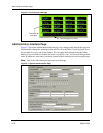
A-2 8946121602
G_Port: A port that has not assumed a specific function. A G_Port is a generic switch port
that can operate either as an E_Port or an F_Port. A port is defined as a G_Port, for
example, when it is not connected or has not yet assumed a specific function in the Fabric.
Interswitch Link (ISL): ISL is a fiber link between two switches
Loop: A configuration of devices (for example, JBODs) connected to the Fabric through an
FL_Port interface card.
Multicast: Multicast is used when multiple copies of data are to be sent to designated multiple
destinations.
N_Port: An equipment port connected to the Fabric.
NL_Port: An equipment port connected to the Fabric in a loop configuration via an FL_Port.
Power on self test (POST): A series of self tests which run each time the unit is booted or
reset.
Resource Allocation Time Out Value (R_A_TOV): R_A_TOV is used to time out
operations that depend on the maximum possible time that a frame could be delayed in a
Fabric and still be delivered. The value of R_A_TOV is adjustable in 1-microsecond
increments over a range from 10 to 120 seconds.
Isolated E_Port: ISL is online but not operational between switches because of overlapping
domain ID or nonidentical parameters such as E_O_TOVs.
Simple Network Management Protocol (SNMP): SNMP is a TCP/IP protocol that generally
uses the User Datagram Protocol (UDP) to exchange messages between a management
information base and a management client residing on a network. Since SNMP does not
rely on the underlying communication protocols, it can be made available over other
protocols, such as UDP/IP.
SNMPv1: The original standard for SNMP is now referred to as SNMPv1.
Trap (SNMP): A mechanism for SNMP agents to notify the SNMP management station of
significant events.
Unicast: Unicast routing provides one or more optimal path(s) between any of two switches
that make up the Fabric. This is for a single copy of the data to be sent to designated
destinations.
World Wide Name (WWN): A WWN uniquely identifies a switch on local and global
networks.


















